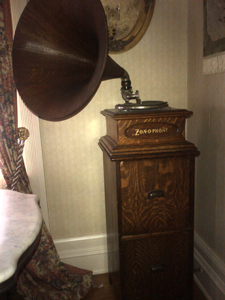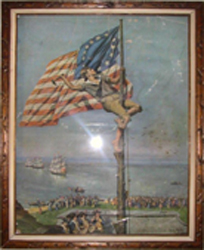 |
|
|||
 |
 |
|||
Copyright © Harry Rinker, LLC 2013 Questions
and Answers QUESTION: Our family owns a Zon-O-Phone phonograph that is good condition. There are several discs stored in the cabinet. We enjoy it as an interesting piece of furniture and occasionally listen to the recordings. What information can you provide about the Zon-O-Phone and its value? – TL, State College, PA, Email Question
Prior to 1899, Seaman was in partnership with Emile Berliner, inventor of the lateral-groove disc record, and Eldridge Reeves Johnson, a machinist who developed a marketable version of Berliner’s Gramophone player. The partners had an agreement that if a less expensive machine could be developed, the company would consider it. Seaman, who had the United States marketing rights to Gramophone, worked with Louis Valiquet to do just that. When Seaman presented the resulting phonograph, the Board refused to accept it. Seaman established the Universal Talking Machine Company and began producing phonographs using Valiquet’s motor under the Zonophone (Zon-O-Phone) brand. Berliner and Johnson sued. Seaman countersued. Seaman enlisted the aid of Columbia Records. Seaman succeeded in obtaining an injunction preventing Berliner and Johnson from producing their machine. Johnson created the Consolidated Talking Machine Company and later the Eldridge R. Johnson Talking Machine Company to evade the injunction. Successful in the countersuit, Johnson renamed his company The Victor Talking Machine Company. In 1903, Victor acquired the Latin American and United States assets of Zon-O-Phone and the Gramophone & Typewriter Company, the British Commonwealth and European rights. Victor produced Zon-O-Phone records until discontinuing the label in 1912 in the United States. The Gramophone Company continued the label until 1931. See: http://en.wikipedia.org/wiki/Zonophone. YouTube contains several videos of Zon-O-Phone phonographs and records. See: www.youtube.com/watch?v=Ait4fP3f-2k. The Universal Talking Machine Company produced five different models using the Valiquet motor. The “Concert Grand,” the top of the line model, featured a nine-inch turntable. Models A through D had a seven-inch turntable. Model A case has two glass side panels that allowed the owner to see the motor. The horn is a brass trumpet-style. The Concert Grand sold for $40.00 and the Model A for $25.00. See: http://www.edisontinfoil.com/zonoa.htm. An eBay seller has a “Concert” phonograph listed at $1,800.00. Thus far, there are no bidders. I did find a 2004 auction listing for a Model A with a starting bid request of $750.00 and an estimate of $1,500.00 to $2,000.00. Judging from the picture that accompanied your email, the cabinet appears to be period and a go-with accessory. Since the machine is in working order but not restored, a reasonable secondary market value is around $1,500.00. Zon-O-Phone records sell through on eBay at values ranging from $10.00 to $20.00 each. You are correct in your assumption that this is an interesting piece of furniture. However, its value is higher to a phonograph collector than as a decorative(accent)/conversation piece.
ANSWER: I am not a fan of folk art. The category contains for too much primitive, crude crap. Further, folk art’s value is heavily based on market hype. Titles such as “Dean of American Toleware” and “Dean of Décor Painting,” two terms often used to describe Peter Ompir, are figments of aggressive dealer marketers. The tragedy is that museum curators and others are easy victims of this promotional nonsense. The folk art field has a major “Emperor’s New Clothes” problem. At some point, someone is going to have to hold their nose and say “this stuff stinks to high heaven.” My opinion is not going to endear me to collectors of Peter Ompir cutesy-poo, warm and fuzzy folk art. Ompir studied art at the Art Institute in Chicago and the National and American Art Academies in the 1930s. The fact that Ompir was academically trained automatically excludes him from the folk art category. Folk artists are traditional untrained artisans. However, the1970s folk art craze blurred this definition. Failing to find work as a portrait painter, he began decorating utilitarian objects such as furniture, pitchers, and common household goods. Eventually, large department stores such as Macy’s and Nieman-Marcus and small gift shops began carrying his work. [Author’s Aside #1: What Ompir became was a commercial artist who hit upon a salable style and subject matter. He cranked out piece after piece, often repeating the same theme over and over again. He was more a copyist than an artist.] Ompir and his partner Warner Wrede eventually moved from New York to Vermont and eventually to Sheffield, Massachusetts. Wrede did the preparation work and underpainting. Ompir added the design. For a more flattering interpretation, see Charlotte Owen’s article on the website: http://josonja.com/index.php?option=com_content&task=view&id= 48&Itemid=9&limitstart=1. Peter Ompir’s work is highly prized by New England and some Middle Atlantic folk art collectors. An eBay “Advanced Search” of completed auctions resulted in a listing of 248 items. Much to my surprise and delight, the secondary market appears down 25 to 40 percent from its high of ten year ago. Occasionally, someone will pay a hefty price. A large wooden lid featuring an image of a wreath filled with fruit sold for $695.00 on March 12, 2013. However, the lot had only 1 bidder. [Author’s Aside #2: One has to wonder if it was the seller trying to prop the market for other pieces. The only cost to the seller is the commission due eBay. Such practices are common among folk art market price manipulators.] Most “Buy It Now” pieces went unsold. A circular tray with an image similar to that on your oval tray closed on March 8, 2013, for $66.77. There were seven bids, which does not translate into seven bidders. The closing price put a smile on my face. Nothing ruins a secondary market like imitators. Peter Ompir imitators such as Judith Key and Porter Rinehart abound. Why pay Ompir prices when you can have virtually an identical piece for one quarter of the price. What then is the value of your Peter Ompir toleware tray? My recommendation is to think conservatively, somewhere between $45.00 and $65.00. QUESTION: I have a print entitled “Stars and Stripes Forever” signed by Henry Mosler and dated 1915. It shows a young soldier atop the flag pole at Fort McHenry as the British fleet sails out of Baltimore Harbor. What is it worth? – DC, Email Question
“Stars and Stripes Forever” was a later illustration. I was unable to discover the origin of the artwork used in the print or where the original artwork is located. The size, subject matter, and pizzazz of your print are all pluses. It is definitely a conversation piece. Its value as it stands is between $85.00 and $100.00. QUESTION: I have a portfolio of four prints by President Dwight Eisenhower. The folder cover reads “The Eisenhower College Collection: A Portfolio of Fine Art Prints from the paintings of our 34th President.” Do they have any value? – I, Janesville, WI ANSWER: The 1968 portfolio of four prints sells between $15.00 and $20.00. When a dealer purchases the portfolio, he/she purchases a cheap frame, frames each print, and asks between $20.00 and $30.00 per print. This doubles the potential value of the portfolio. Eisenhower was a reasonably accomplished amateur landscape painter. His art is primarily copies of photographs and other illustrations. His works are collected because of Eisenhower’s historical importance and not as great works of art. Sister Wendy Beckett’s article “President Eisenhower: Painter” is found at: http://www.whha.org/whha_publications/publications_ documents/whitehousehistory_21.pdf.Harry L. Rinker welcomes questions from readers about
collectibles, those mass-produced items from the twentieth and twenty-first centuries.
Selected letters will be answered in this column.
Harry cannot provide personal answers.
Photos and other material submitted cannot be
returned.
Send your questions to: Rinker on Collectibles, 5955 Mill
Point Court SE, Kentwood, MI 49512.
You also can e-mail your questions to
harrylrinker@aol.com.
Only e-mails containing a full name and mailing address
will be considered.
You can listen
and participate in
WHATCHA GOT?, Harry’s
antiques and collectibles radio call-in show, on Sunday mornings between 8:00 AM
and 10:00 AM Eastern Time.
If you
cannot find it on a station in your area,
WHATCHA GOT?
streams live on the Internet at www.gcnlive.com.
SELL, KEEP OR TOSS?: HOW TO DOWNSIZE A HOME,
SETTLE AN ESTATE, AND APPRAISE PERSONAL PROPERTY
(House of Collectibles, an imprint of Random House Information Group, $17.99),
Harry’s latest book, is available at your favorite bookstore and via
www.harryrinker.com.
|
||||
 ANSWER: Frank Seaman of Camden, New Jersey founded Zonophone, also known as Zon-O-Phone, as a record label in 1899. Seaman’s Universal Talking Machine Company manufactured the Zon-O-Phone phonograph from 1899 to 1903. Because of its limited period of production, the Zon-O-Phone is one of the scarcer American-made phonographs, although several appear for sale each year.
ANSWER: Frank Seaman of Camden, New Jersey founded Zonophone, also known as Zon-O-Phone, as a record label in 1899. Seaman’s Universal Talking Machine Company manufactured the Zon-O-Phone phonograph from 1899 to 1903. Because of its limited period of production, the Zon-O-Phone is one of the scarcer American-made phonographs, although several appear for sale each year. QUESTION: I have a 14in long toleware tray that is hand decorated and signed on the back “Peter Ompir.” The central design is that of a standing male in a Colonial era costume. The colors are yellow and brown earth tones. The top flat portion had a bird design and bottom flat portion a heart design. What is this worth? – G, Altoona, PA, Email Question
QUESTION: I have a 14in long toleware tray that is hand decorated and signed on the back “Peter Ompir.” The central design is that of a standing male in a Colonial era costume. The colors are yellow and brown earth tones. The top flat portion had a bird design and bottom flat portion a heart design. What is this worth? – G, Altoona, PA, Email Question ANSWER: Henry Mosler (June 6, 1841 – April 21, 1920) was a professional artist who did painting, sketches, and illustrations often focused on historical events. Born in Tropplowitz, Silesia, then part of Germany, he moved to New York in 1849 with his family. By 1851, the family was located in Cincinnati. As a member of the German-Jewish community, he was apprenticed to wood engraver Horace C. Grosvenor. He returned to Dusseldorf in 1863 to study painting. His travels took him back and forth between Cincinnati and Europe. Mosler won medals at exhibitions in Paris (1888) and Vienna (1893). He became a resident of New York in 1894. See:
ANSWER: Henry Mosler (June 6, 1841 – April 21, 1920) was a professional artist who did painting, sketches, and illustrations often focused on historical events. Born in Tropplowitz, Silesia, then part of Germany, he moved to New York in 1849 with his family. By 1851, the family was located in Cincinnati. As a member of the German-Jewish community, he was apprenticed to wood engraver Horace C. Grosvenor. He returned to Dusseldorf in 1863 to study painting. His travels took him back and forth between Cincinnati and Europe. Mosler won medals at exhibitions in Paris (1888) and Vienna (1893). He became a resident of New York in 1894. See: